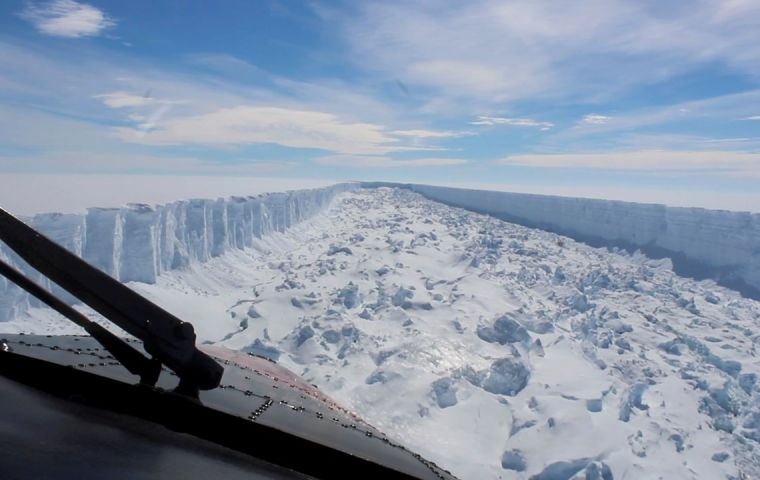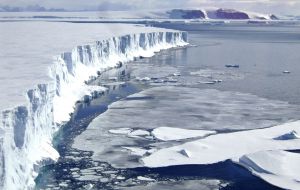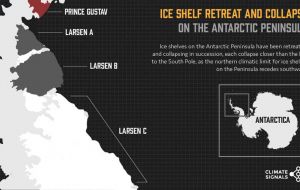MercoPress. South Atlantic News Agency
Huge iceberg breaks free from the Antarctica Larsen C ice shelf
 Larsen C is about 1100 feet thick and rests at the edge of West Antarctica, blocking the glaciers that feed into it.
Larsen C is about 1100 feet thick and rests at the edge of West Antarctica, blocking the glaciers that feed into it.  All of the region’s ice shelves, including Larsens A, B, and C, impede the movement of Antarctic glaciers, which, if they float into the ocean, can hasten sea-level rise.
All of the region’s ice shelves, including Larsens A, B, and C, impede the movement of Antarctic glaciers, which, if they float into the ocean, can hasten sea-level rise.  The Larsen A ice shelf collapsed in 1995 and the Larsen B shelf suddenly crumbled in 2002 after a similar rift developed.
The Larsen A ice shelf collapsed in 1995 and the Larsen B shelf suddenly crumbled in 2002 after a similar rift developed. An iceberg the size of Delaware has broken free from an Antarctic ice shelf, leaving the rest of the shelf vulnerable to collapse and serving as a harbinger of future sea-level rise that could pose a serious threat to coastal communities such as the Falkland Islands.
The break in the Larsen C ice shelf , the most northern major ice shelf in the region occurred Wednesday, according to Project MIDAS, a UK-based monitoring group.
Ice shelves are the thick, floating ice at the edge of the continent, and they serve as buttresses, keeping onshore glaciers from sliding into the sea. Researchers have been monitoring the rift in the Larsen C shelf for years and became alarmed in December when the breach widened dramatically. At one point this spring, the rift grew by 11 miles in less than a week, leaving only eight miles left and raising fears that a complete break was imminent. More than six months later — in the middle of the Antarctic winter — the break has occurred.
“The situation with the Larsen [C] ice shelf is a combination of fascinating and troubling, a tangible piece of a larger slow-motion disaster unfolding in front of our eyes,” said Michael Oppenheimer, professor of geosciences and international affairs at Princeton University. “We are seeing a microcosm of the future… a future that may already be inevitable and, if not, will likely be so if we transgress the 2º C warming target.”
Larsen C is about 1100 feet thick and rests at the edge of West Antarctica, blocking the glaciers that feed into it. All of the region’s ice shelves, including Larsens A, B, and C, impede the movement of Antarctic glaciers, which, if they float into the ocean, can hasten sea-level rise.
The Larsen A ice shelf collapsed in 1995 and the Larsen B shelf suddenly crumbled in 2002 after a similar rift developed.
“One of the processes causing the disintegration of the Larsen… is also implicated in the rapid changes in the Amundsen Sea area of West Antarctica — Thwaites glacier, Pine Island glacier,’’ said Oppenheimer, a long-time participant in the UN Intergovernmental Panel on Climate Change. When land-based ice goes into the ocean, it causes sea-level rise.
“There is a relatively small amount of ice behind the Larsen, so even if it all disintegrated, the contribution to sea-level rise would be modest, a few inches,’’ he said. Still, even a few inches of sea-level rise is meaningful, especially when combined with storm surge in low-lying areas.
And what is happening with Larsen C is not an isolated problem. Cracks in other Antarctic ice shelves also have developed.
“There is several meters worth of ice behind the other ice shelves and more behind vulnerable ice shelves in East Antarctica. So what we are seeing is a vivid demonstration of what warm water and warm air can do to an ice shelf and the land-based ice sheet that the shelf has been restraining,” Oppenheimer said.
With the break, Larsen C lost more than 10% of its area, leaving the ice front at the most retreated position on record, according to Project Midas.




Top Comments
Disclaimer & comment rules-

-

-

Read all commentsArgentina promptly clammed the iceberg and plans are underway to tow it to Buenos Aires.
Jul 16th, 2017 - 01:02 pm +1We are all doomed I say, all doomed.
Jul 13th, 2017 - 10:14 am 0For anyone like me who has no idea how big Delaware is, the new iceberg has about the same area as East Falkland.
Jul 14th, 2017 - 12:41 am 0Commenting for this story is now closed.
If you have a Facebook account, become a fan and comment on our Facebook Page!